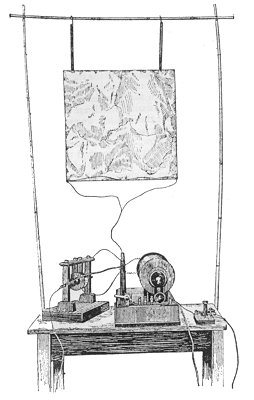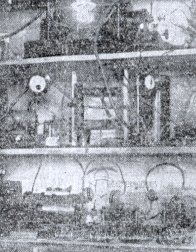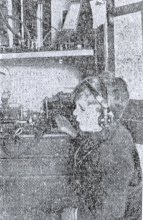This is a brief history of radio development, starting from the early
years to the time when radio manufacturing ended at Wolverhampton. Any
description of the developments will inevitably be of a technical
nature. Actual descriptions of some of the circuits have been included,
but these are separate to the main text, so if you are not interested in
the technicalities, they can be ignored.
Beginnings
James Clerk Maxwell, the Scottish physicist, was born on the 13th of
June 1831, in Edinburgh. He was very interested in Michael Faraday’s
work on electromagnetism. Faraday explained that electric and magnetic
effects result from lines of force that surround conductors and magnets.
Maxwell drew an analogy between the behaviour of the lines of force and
the flow of a liquid, deriving equations that represent electric and
magnetic effects. In 1855 he produced a paper which built on Faraday’s
ideas, and in 1861 developed a model for a hypothetical medium, that
consisted of a fluid which could carry electric and magnetic effects. He
also considered what would happen if the fluid became elastic and a
charge was applied to it. This would set up a disturbance in the fluid,
which would produce waves that would travel through the medium. The
German physicists Friedrich Kohlrausch and Wilhelm Weber calculated that
these waves would travel at the speed of light. Maxwell finally
published this work in his ‘Treatise on Electricity and Magnetism’ in
1873.
In 1888 German physicist Heinrich Hertz made the sensational
discovery of radio waves, a form of electromagnetic radiation with
wavelengths too long for our eyes to see, confirming Maxwell's ideas. He
devised a transmitting oscillator, which radiated radio waves, and
detected them using a metal loop with a gap at one side. When the loop
was placed within the transmitter’s electromagnetic field, sparks were
produced across the gap. This proved that electromagnetic waves could be
sent out into space, and be remotely detected. These waves were known as
‘Hertzian Waves’ and Hertz managed to detect them across the length of
his laboratory.
|

Guglielmo Marconi and his family in 1933.
|
Italian born Guglielmo Marconi was
fascinated by Hertz’s discovery, and realised that if radio
waves could be transmitted and detected over long distances,
wireless telegraphy could be developed. He started experimenting
in 1894 and set up rough aerials on opposite sides of the family
garden. He managed to receive signals over a distance of 100
metres, and by the end of 1895 had extended the distance to over
a mile. He approached the Italian Ministry of Posts and
Telegraphs, informing them of his experiments. The Ministry was
not interested and so his cousin, Henry Jameson-Davis arranged
an interview with Nyilliam Preece, who was Engineer-in-Chief to
the British Post Office. |
| He came to England in February 1896 and gave
demonstrations in London at the General Post Office Building.
His transmissions were detected 1.5 miles away, and on 2nd
September at Salisbury plain the range was increased to 8 miles.
In 1897 he obtained a patent for wireless telegraphy, and
established the Wireless Telegraph and Signal Company at
Chelmsford. The world’s first radio factory was opened there in
1898. On 11th May 1897 tests were carried out to
establish that contacts were possible over water. A transmitter
was set up at Lavernock Point, near Penarth and the
transmissions were received on the other side of the Bristol
Channel at the Island of Holm, a distance of 3.5 miles. The
Daily Express was the first newspaper to obtain news by wireless
telegraphy in August 1898, and in December of that year
communication was set up between Queen Victoria’s Royal yacht,
off Cowes and Osborne House. The Queen received regular
bulletins on the Prince of Wales’ health, by radio, from the
yacht, where he was convalescing. |

An early Marconi transmitter. |
Also in December of that year, wireless communication was set up
between the East Goodwin light ship and the South Foeland lighthouse. On
3rd March 1899 Marconi obtained a lot of publicity when the
first life was saved by wireless telegraphy, which was used to save a
ship in distress in the North Sea. By the summer cross channel
communication had been established and the first ocean newspaper
published bulletins sent by wireless.

About this time Marconi began to develop tuned circuits for wireless
transmission, so that a wireless can be tuned to a particular frequency,
to remove all other transmissions except the one of interest. He
patented this on 26th April 1900, under the name of ‘Tuned
Syntonic Telegraphy’.
|

The transmitter at Poldhu. |
On Thursday 12th December 1901, Marconi
and his associates succeeded in transmitting a signal across the
Atlantic Ocean. He sailed to Newfoundland with G.S. Kemp and
P.W. Paget, and received a transmission from Poldhu, Cornwall.
The transmission was received at Signal Hill using a kite
aerial. The British government and admiralty were greatly
impressed and many people wanted to invest in the new
technology. |
Demand grew and large numbers of ships carried
the new apparatus, which saved many lives at sea. One of the most famous
occasions was when the Titanic sank. Signals transmitted by its Marconi
wireless summoned help and saved many lives.
Receivers at this time were mainly crystal sets, which were extremely
insensitive and unselective. They were connected to a pair of headphones
and required a long aerial.
| Descriptions of the Early
Transmitters and Receivers |

|
At this time wireless was strictly controlled by the Post Office. It
was a simple matter to obtain a receiving licence but much more
difficult to obtain permission to use a transmitter. In order to do so
the Post Office had to be satisfied that the applicant had suitable
engineering qualifications, or knowledge to operate the transmitter.
Transmitter output power was restricted to ten watts, and use was only
permitted for scientific research or for something of use to the public.
A small number of radio amateurs were transmitting before the first
world war. We had at least two in Wolverhampton; Harry Stevens of
Oaklands Road and Mr. J. Vincent Waine of Helmsley Lodge, Wednesfield.
|

One of Mr. Waine's aerials.
|
Mr. Waine, who began transmitting in about 1898
became well known locally when he received the S.O.S. that was
transmitted by the Narrung P.&O. liner, during a gale in the
Channel, on Boxing Day 1912. Wireless was his main hobby, he was
an enthusiastic amateur and recorded messages from places as far
as Russia, Austria, Hungary, Italy, Africa and America. He
designed and built all of his transmitting and receiving
equipment, including a spark gap transmitter and a special
sensitive detector. He was never satisfied with the equipment
and always strived to improve its performance. Mr. Waine's call
sign was 'ZAX'. The three aerials in his back garden used
something like 3,000ft of wire. The equipment was housed in a
cupboard in the dining room so that it could be operated in
comfort. |
| Mr Waine also had links with commercial radio
companies and was associated with Marconi, Dr. Fleming and Sir
Henry Jackson, who was Admiral of the Fleet. He also gave
financial assistance to Mr. John Logie Baird the television
pioneer.
The opposite photograph shows Mr.
Waine's indoor equipment. |
 |
 |
Mr. Waine's eight and a half year old son,
Vincent, was also a keen radio enthusiast and eagerly used his
father's equipment. He possessed a miniature wireless set
capable of receiving and transmitting over three miles. |
| Mr. Waine and his family
acquired the Point of Air Lighthouse, at the mouth of the River
Dee, as a weekend holiday home, in the early 1930's. As well as
a weekend retreat it was used as a base for much of his
experimental work.
The photograph opposite shows Mr. Waine
and Vincent receiving a message. |
 |
I would like to thank Peter Waine for the information about his
father's wireless station.

|
|
 |
|

|
Proceed to
The Valve Era |
|
Return to
A.J.S. |
|
Return to
Ever Ready |
|



